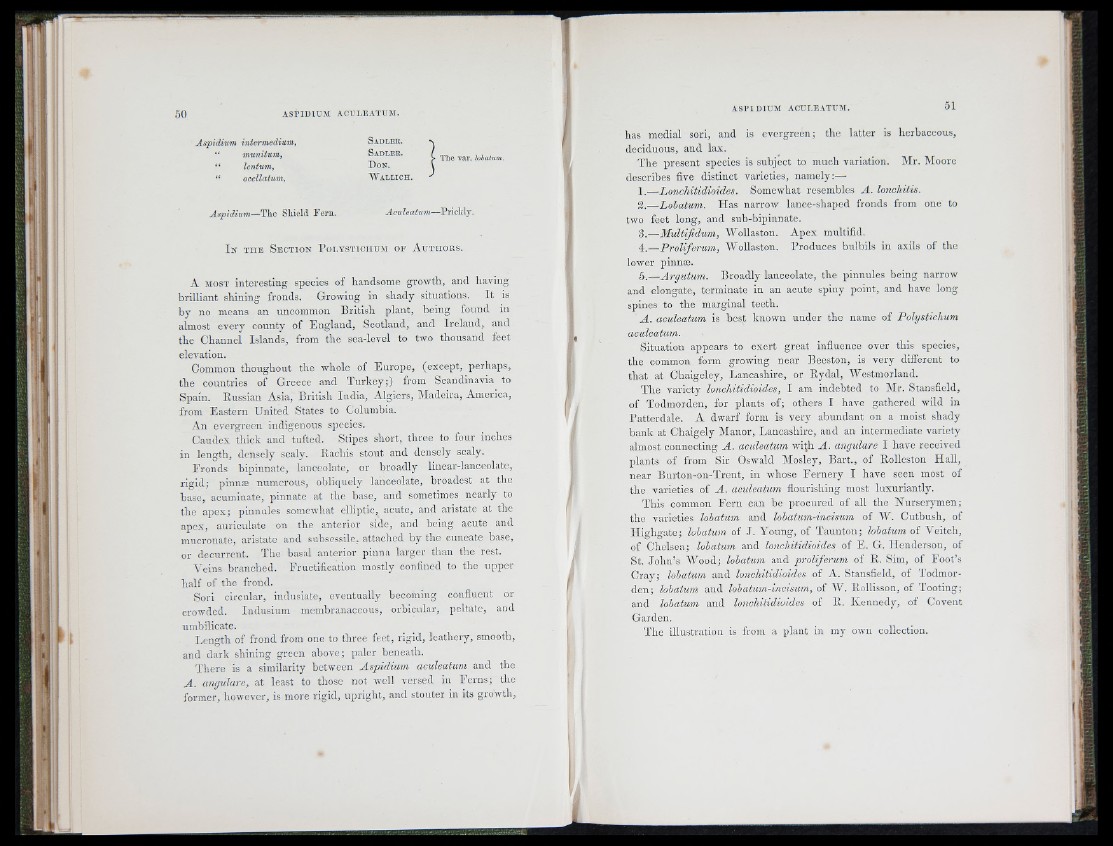
Aspidium intermedium,
" munitum,
“ lentum,
“ ocellatum.
Aspidium—The Shield Fern.
S a d l e k .
S a d l e k .
D o n .
W a l l ic h .
The var. hhatuin.
Aculeatum—VnoMiy.
I n t h e S e c t io n F o l y s t ic h u m o f A u t h o r s .
A MOST interesting species of handsome growth, and liaving
brilliant shining fronds. Growing in shady situations. I t is
by no means an uncommon British plant, being found iu
almost every county of England, Scotland, and Ireland, and
tlie Channel Islands, from the sea-level to two thousand feet
elevation.
Common thoughout the whole of Europe, (except, perhaps,
the countries of Greece and Turkey;) irom Scandinavia to
Spain. Russian Asia, British India, Algiers, Madeira, America,
from Eastern ETnited States to Columbia.
An evergreen indigenous species.
Caudex thick and tufted. Stipes short, three to four inches
in length, densely scaly. Rachis stout and densely scaly.
Fronds bipinnate, lanceolate, or broadly linear-lanccolatc,
rigid; pinnæ numerous, obliquely lanceolate, broadest at the
base, acuminate, pinnate at the base, and sometimes nearly to
the apex; pinnules somewhat elliptic, acute, and aristato at the
apex, auriculate on the anterior side, and being acute and
mucronate, aristate and subsessile, attached by the cuneate base,
or decurrent. The basal anterior pinna larger than the rest.
Veins branched. Fructification mostly confined to the upper
half of the frond.
Sori circular, indusiatc, eventually becoming confluent or
crowded. Indusium membranaceous, orbicular, peltate, and
unibilicate.
Length of frond from one to three feet, rigid, leathery, smooth,
and dark shining green above; paler beneath.
There is a similarity between Aspidium aculeatum and the
A . angulare, at least to those not well versed in Ferns; the
former, however, is more rigid, upright, aud stouter in its growth,
a s p id iu m a c u l e a t u m . 51
has medial sori, and is evergreen; the latter is herbaceous,
deciduous, and lax.
The present species is subject to much variation. Mr. Moore
describes five distinct varieties, namely:—■
1.— Lonchitidioides. Somewhat resembles A . lonchitis.
2.—Lohatum. Has narrow lance-shaped fronds from one to
two feet long, and sub-bipinnate.
3.—Multifidum, Wollaston. Apex multifid.
4.—Proliferum, AVollaston. Rroduces bulbils in axils of the
lower pinnæ.
5.— Argutum. Broadly lanceolate, the pinnules being narrow
and elongate, terminate in an acute spiny point, and have long
spines to the marginal teeth.
A . aculeatum is best known under the name of Polystichum
aculeatum.
Situation appears to exert great influence over this species,
the common form growing near Beeston, is very different to
that at Chaigeley, Lancashire, or Rydal, AVestmorland.
The variety lonchitidioides, I am indebted to Mr. Stansfield,
of Todmorden, for plants of; others I have gathered wild in
Fatterdale. A dwarf form is very abundant on a moist shady
bank at Chaigely Manor, Lancashire, and an intermediate variety
almost connecting A . aculeatum with A . angulare I have received
plants of from Sir Oswald Mosley, Bart., of Rolleston Hall,
near Burton-on-Trent, in whose Fernery I have seen most of
the varieties of A . aculeatum flourishing most luxuriantly.
This common Fern can he procured of all the Nurserymen;
the varieties lohatum and lohatum-incisum of W. Cutbush, of
Highgate; lohatum of J. Young, of Taunton; lohatum of A°eitch,
of Chelsea; lohatum and lonchitidioides of E. G. llenderson, of
St. John’s ATood; lohatum and proliferum of R. Sim, of Foot’s
Cray; lohatum and lonchitidioides of A. Stansfield, of Todmorden;
lohatum and lohatum-incisum, of AA'^. Rollisson, of Tooting;
and lohatum and lonchitidioides of R. Kennedy, oi Covent
Garden.
The illustration is from a plant in my own collection.